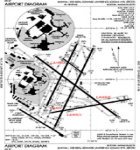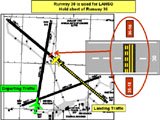LAHSO (Land and Hold Short Operations)
LAHSO (Land and Hold Short Operations) is an ATC (Air Traffic Control) procedure that requires landing aircraft to stop before reaching an intersecting runway used for other arrival or departing aircraft. It is used mainly at large and busy airports where it helps in increasing airport capacity and decreasing delays by using intersecting runway operations.
Some of the criteria that the FAA uses to approve LAHSO for a particular runway include: Is landing distance sufficient to stop for a particular aircraft? Is a visual light system available? Has a RLP (Rejected Landing Procedure) been modeled and tested? A RLP is a procedure used by the landing aircraft if it has to reject the landing ("go-around"). The landing aircraft will fly a predetermined heading and remain clear of clouds to avoid any potential for a collision in case there is a departing aircraft on the other runway. As you might imagine, this could be a deadly situation with two converging aircraft.
When LAHSO is in effect, it will be broadcast by the airport's ATIS (Airport Terminal Information System - more on this in a later section). Your destination airport operations/tower has determined that the existing weather and runway conditions can help increase the arrival and departure rates by the use of LAHSO operations. The weather? No precipitation and winds are light. The cloud ceiling is at least 1500 feet and visibility is at least 5 miles. If there is a visual landing system available and working, the cloud ceiling can be reduced to 1000 feet and visibility to 3 miles.
Your pilots will check their applicable airline FOM (Flight Operations Manual), AFM (Aircraft Flight Manual), and/or approach "plates" (charts) to determine if your aircraft meets certain criteria; and that they can accept the LAHSO landing clearance for the runway assigned. If there is an approach plate for that particular runway it means that the procedure has been approved and agreed upon by the FAA (Federal Aviation Administration) and the particular airline you are flying on. It would usually be titled something like "LAHSO Runway......".

|

|
| LAHSO Example | LAHSO Example |
Other criteria your pilots use to judge whether to accept the LAHSO procedure are:
1) the forecast landing weight of your aircraft
2) if there are any system problems that would hinder stopping
3) landing distance available
4) if runway is contaminated (has no snow, ice)
5) tailwind of less then 3 knots
6) no windshear reported
7) visual landing guidance system
For example, your pilots could hear the following on the ATIS concerning LAHSO operations: "LAHSO in effect, expect landing on runway........, to hold short of runway......" When your pilots check in with Approach Control, they will say "Mountain Air 77 has information Alpha ("A")".
This signifies that they know the information contained in the ATIS, but as pertains to this topic, acknowledge that they can accept a LAHSO clearance. If they couldn't, then of course they would say so. This should give Approach Control and the respective Tower Operations, sufficient time to plan an alternate course of action for your arrival.
LAHSO back to My Airline Flight